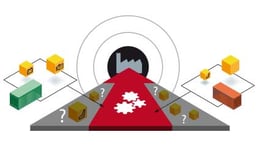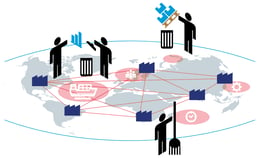How to Choose the Right Transportation Planning Solution
Brian Hoey - November 17, 2020

 Planning routes, tours, and frequencies sounds simple enough—but anyone who’s experienced the world of shipping and logistics knows that it’s anything but. In fact, it’s getting more difficult and complex all the time as global supply networks become more complex and customer expectations for on-time delivery become more exacting. Planners need the right tools for the job, and in the digital era that means moving past Excel spreadsheet and rudimentary planning software towards a true transportation planning solution.
Planning routes, tours, and frequencies sounds simple enough—but anyone who’s experienced the world of shipping and logistics knows that it’s anything but. In fact, it’s getting more difficult and complex all the time as global supply networks become more complex and customer expectations for on-time delivery become more exacting. Planners need the right tools for the job, and in the digital era that means moving past Excel spreadsheet and rudimentary planning software towards a true transportation planning solution.
But how do you know which solution to adopt? Well, that depends on your needs and the exact nature of your supply chain technology. That said, there are plenty of needs that are universal among planners, so it stands to reason that some features in planning solutions should be mission critical across the board. The old distinction between features and benefits applies here: while you’ll generally need to assess a software solution based on the features it advertises, you should always be examining them with an eye towards what tangible benefits that they actually provide for planners.
What Do Planners Need?
In order to figure out what planners need to look for in their transportation management IT, we need to consider what, exactly, those planners need to be able to do within their workflows. At the absolute highest level of abstraction, you need to create plans that maximize on-time delivery performance while minimizing costs, operationalize those plans successfully within a complex value chain, and change those plans rapidly as conditions change. This boils down to three things that a planner needs to succeed:
- Rapid Decision Making: Right off the bat, you need to be able to make decisions quickly. Freight prices and demand fluctuate, and capacity needs can be hard to predict in advance, which means you need to be able to pick the right carrier at the right price at the right time--or the right route with the right tours across the right network elements. You need to be proactive about reserving capacity and setting the right routes, but you don’t want to lock in your plan too far ahead of time in case conditions change. This means that the only way forward is to be able to take in all relevant data quickly, and analyze it instantaneously to uncover the optimal path.
- Flexibility and Elasticity: Of course, even if you do everything optimally right off the bat, conditions can change quickly. A large order might fall through, or a truck in your network might break down, and it’ll be incumbent upon you to call an audible and get things back on track. To make this happen, you need to be able to visualize all of your potential logistics planning options and compare them against one another. In all likelihood, this means being able to digitally model your entire transport network in order to simulate the effects of possible real-time decisions, so that you can preserve value even as the situation continues to unfold.
- Accuracy: Just because you do something quickly doesn't mean you’ve done it right. To be able to perform the optimal planning flows we described above, you need to gather accurate data in real-time, not just from the different elements of your transport network (trucks, warehouses, even individual pallets or containers) but also other touchpoints on the value chain. This might include sales data that helps inform your planning parameters, up-to-date inventory information, and anything else that can have an impact on transportation planning—such that you can always access an up-to-date visualization of the value chain and its parameters.
What Features Provide for Flexible, Integrated Planning and Scheduling?
Okay, so you want to make decisions quickly, leveraging a large quantity of up-to-the-minute information and built-in supply chain flexibility. How do you make that happen? You can start by looking out for a few specific features:
- Strategic Network Modeling: In the digital era, the baseline functionality you’ll need is the ability to digitally model your transportation network. You should be able to take in live information from assorted touchpoints on the chain, and then let those data points inform a responsive, highly-visible digital representation of your network. In this way, you can take the guesswork out of how new and emerging situations will impact your network, and you can pinpoint areas of strategic importance. In this way, you can match your network capacity to expected supply chain needs on a high level, with an eye towards the most cost-effective network layouts.
- Network Planning and Optimization: Once you have the kind of modeling capabilities we described above, your ideal transportation planning solution should be equipped with advanced analytics that can leverage digital data into network and planning optimizations. Once the relevant information is centralized, your solution should be able to automatically seek out areas of waste or potential improvements in the structure of the transport network itself. Not only that, but you should be able to run those same sorts of analytics on smaller-scale things like individual routes and tours, in order to create the best fit between your capacity and your routes, tours, and modes—and set yourself up for more efficient schedules in the process.
- Network Operational Planning: The two items above should give you excellent coverage for strategic and tactical planning decisions, but to truly maintain flexibility you’ll also need to cover execution. This means that your solution should offer dynamic routing and live supply chain feedback, such that you have the ability to perform rapid replannings of individual routes and tours as new conditions emerge. In this way, you make sure that something as simple as a traffic jam doesn’t have the power to throw off your carefully optimized plans.
Transportation Planning in Postmodern ERP
Hopefully, the paragraphs above have given you relatively firm guidance on what a transportation planning solution should enable you to do, and what features actually enable you to do so. This is a good start in any software procurement process, but there is one last consideration to be aware of: cloud vs. on-premise. As ever, the right option here will depend in large part on the specifics of your existing IT environment and your larger corporate goals. At the same time, the power of the cloud for facilitating flexible planning is worth pointing out.
Because cloud software deployments can be scaled up or down as needed, and are frequently designed to integrate and interwork with other software solutions, they represent an elegant way to avoid the “ERP trap,” in which rigid, top-down software deployments result in silos and shadow IT. By hosting your transportation planning solution in the cloud, you can make it an integral part of your larger “postmodern ERP” strategy, in which each team is able to use the solution that’s best suited to its needs. This prevents the adoption of shadow IT, and in that way creates shared IT environments that power optimal data collection and processing end-to-end. The result is more efficient planning and scheduling—and usually reduced IT costs as well.
LATEST POSTS
- Understand Why Production Planning Needs Specialized Solutions
- Understand Circular Economy in The Manufacturing Industry
- How Can Industry 4.0 IT Integration Be Achieved Smoothly?
- The Significance of Order Sequencing in Discrete Manufacturing
- How to improve your Supply Chain Management: The Power of Control Towers



